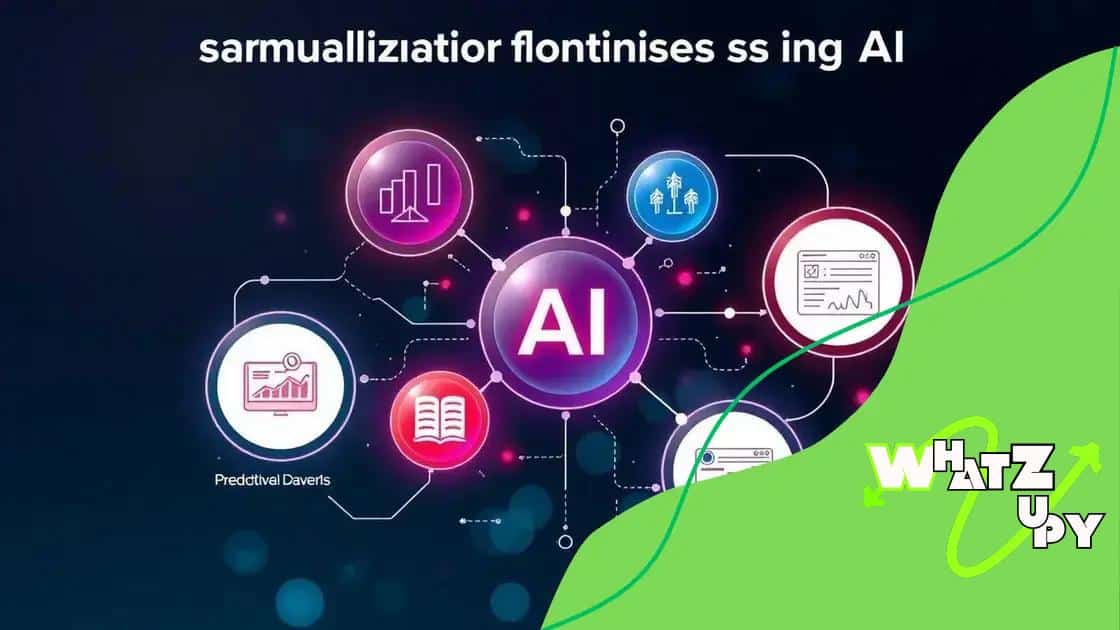How AI personalizes customer journeys in ecommerce

AI personalizes customer journeys in ecommerce by leveraging data to create tailored shopping experiences, enhance customer support, and improve marketing strategies through hyper-personalization and predictive analytics.
How AI personalizes customer journeys in ecommerce is reshaping the retail landscape by tailoring experiences to individual needs. Imagine visiting an online store that knows just what you like—sounds intriguing, right? Let’s dive deeper into how this technology makes it possible.
Understanding customer journeys in ecommerce
Understanding the customer journey in ecommerce is vital for businesses aiming to improve their sales and retention rates. By analyzing how customers interact with an online store, companies can tailor their offerings effectively.
The customer journey can be broadly divided into several stages. Each stage presents unique challenges and opportunities for personalization. Let’s take a look at these stages.
Aware Stage
In the aware stage, potential customers realize a need or desire. This is often triggered by advertisements, social media posts, or recommendations from friends. Here are a few key points:
- Effective marketing strategies can attract attention.
- Utilizing SEO helps in appearing in search results.
- Engaging social media content boosts visibility.
Consideration Stage
Once customers are aware of their needs, they start comparing options. At this point, offering personalized recommendations can make a significant difference. When they visit your site, consider:
- Displaying related products based on their browsing history.
- Utilizing user-generated content like reviews.
- Applying targeted email campaigns to highlight deals.
By offering tailored experiences during this stage, you increase the chances of conversion. Additionally, customers appreciate when brands recognize their preferences.
Purchase Stage
During the purchase stage, simplicity is key. Customers want a smooth transition from decision to purchase. Ensuring that the checkout process is efficient can prevent cart abandonment.
Elements that contribute to a positive shopping experience include:
- A quick and easy checkout process.
- Multiple payment options.
- Clear return policies that build trust.
After the purchase, it’s essential to continue engagement. This could involve sending follow-up emails or personalized offers.
Understanding the customer journey in ecommerce is about recognizing these distinct stages and knowing how to create a seamless experience. By focusing on personalization at each touchpoint, businesses can significantly enhance customer satisfaction and loyalty.
The role of AI in data analysis
The role of AI in data analysis is becoming increasingly crucial for businesses looking to gain insights and improve decision-making. By using machine learning algorithms, companies can process vast amounts of data efficiently and effectively.
AI helps in identifying patterns that humans may overlook. This capability allows businesses to make informed predictions about customer behavior and market trends.
Automating Data Processing
One significant advantage of AI is its ability to automate data processing tasks. This automation speeds up operations and reduces human errors. Here are some key benefits:
- Faster processing of large datasets.
- Consistent data quality and integrity.
- Real-time analysis for timely decision-making.
Enhanced Insights and Predictions
With AI, businesses can enhance their insights into customer behavior. Algorithms analyze past data to predict future actions, creating accurate customer profiles. Such insights enable personalized marketing, leading to better engagement.
For example, AI systems can analyze purchase history and browsing behavior, allowing businesses to tailor product recommendations. This approach increases conversion rates and customer satisfaction.
Moreover, AI-powered analysis can uncover hidden trends in data. Companies can identify opportunities for growth or areas where they need to improve. By leveraging these insights, businesses can adapt their strategies more effectively.
Implementation in Various Industries
The implementation of AI in data analysis varies across industries. For instance, in retail, it helps optimize inventory management based on customer demand patterns. In finance, AI analyzes transaction data to identify fraudulent activities.
Healthcare organizations use AI to analyze patient data, aiding in diagnostics and tailored treatment plans. Each industry benefits differently but collectively emphasizes the versatility of AI in data analysis.
Personalization techniques using AI

Personalization techniques using AI are transforming how businesses engage with customers. By leveraging data and machine learning, companies can create tailored experiences that resonate with individual preferences.
These techniques enhance user experiences by offering relevant recommendations and targeted promotions. Understanding how AI personalizes experiences can greatly improve customer satisfaction and loyalty.
Data-Driven Recommendations
One of the most effective personalization techniques is utilizing customer data to make recommendations. AI analyzes purchase history and browsing patterns to suggest products.
- Engaging with customers based on their past interactions.
- Using collaborative filtering to find similar customer preferences.
- Incorporating real-time data to refine suggestions instantly.
Dynamic Content Customization
AI also allows for customizing the content displayed to users. By evaluating user behavior, businesses can present tailored content that resonates with their interests.
This may include:
- Adapting website layouts based on user preferences.
- Showing personalized email campaigns that align with customer interests.
- Utilizing targeted ads that reflect users’ shopping habits.
By personalizing content, businesses can significantly increase engagement rates. Customers are more likely to interact with content that reflects their tastes.
Predictive Analytics for Targeted Marketing
Another innovative use of AI in personalization is predictive analytics. This technique anticipates future customer behavior based on historical data.
Businesses can identify which products a customer is likely to purchase next, allowing them to:
- Send timely promotions based on predicted purchases.
- Adjust inventory based on anticipated demand.
- Improve customer retention by understanding needs before they arise.
Using predictive analytics ensures that marketing efforts are both relevant and timely, increasing conversion rates.
Real-world examples of AI in ecommerce
Real-world examples of AI in ecommerce showcase the powerful impact this technology has on businesses and customers alike. Numerous companies leverage AI to enhance customer experiences and streamline operations.
These implementations demonstrate how AI-driven strategies can unlock potential and achieve remarkable results.
Personalized Shopping Experiences
Many ecommerce giants use AI to create personalized shopping experiences. For instance, Amazon utilizes algorithms to recommend products based on customer browsing and purchase history.
- It suggests items that reflect a user’s past behavior.
- These recommendations can significantly boost sales and improve customer satisfaction.
- Customers feel that the shopping experience is tailored to their preferences.
Chatbots for Customer Service
Another popular application is deploying chatbots for customer service. Companies like Zalando use AI-powered chatbots to assist customers with inquiries and issues.
These chatbots serve various purposes:
- Providing instant answers to common questions.
- Helping customers navigate the website.
- Offering personalized product suggestions.
This use of AI improves customer satisfaction and reduces operational costs by automating responses.
Inventory Management Optimizations
AI also aids in optimizing inventory management. For example, Walmart employs AI to predict demand for products. This ensures they stock items efficiently, reducing waste and shortages.
Key benefits include:
- Improved forecasting accuracy based on historical data.
- Minimizing excess inventory through smarter supply chain management.
- Enhancing customer satisfaction by ensuring product availability.
These real-world applications highlight how AI is reshaping the ecommerce landscape, enabling businesses to thrive in a competitive environment.
Future trends in AI and customer experience
Future trends in AI and customer experience promise to revolutionize how businesses interact with consumers. As technology evolves, companies will increasingly rely on AI to enhance engagement and satisfaction.
Understanding these trends provides valuable insights into how to stay ahead in the competitive ecommerce landscape.
Hyper-Personalization
One significant trend is hyper-personalization. This approach goes beyond basic recommendations to deliver tailored experiences that resonate deeply with individual customers.
- AI analyzes vast amounts of data to predict customer needs.
- This allows for personalized marketing messages at the right time.
- Brands may curate entire shopping experiences unique to each user.
Voice and Visual Search
Voice and visual search technologies are also gaining traction. Customers now expect to search for products using voice commands or images rather than typing.
This trend is influencing AI developments:
- Seamless integration with smart devices simplifies searches.
- Visual recognition technology enhances product discovery.
- Businesses must optimize their content for these new search methods.
AI-Driven Customer Support
AI-driven customer support will continue to evolve. Chatbots and virtual assistants are becoming more sophisticated, capable of understanding complex queries.
Future advancements will include:
- Multilingual support to cater to global customers.
- Emotion recognition to provide more empathetic responses.
- Integration with CRM systems for a seamless customer experience.
By leveraging AI in customer support, businesses can significantly enhance customer satisfaction and loyalty.
Predictive Analytics for Anticipating Needs
Another trend is the use of predictive analytics to anticipate customer needs and behaviors. AI algorithms will analyze patterns to forecast future actions.
Benefits of this trend include:
- Identifying upcoming market trends before competitors.
- Personalizing marketing campaigns based on predicted behaviors.
- Reducing churn by proactively addressing customer issues.
The future of AI in customer experience holds immense potential, pushing the boundaries of how businesses connect with their consumers.
FAQ – Frequently Asked Questions about AI in Ecommerce
What is hyper-personalization in ecommerce?
Hyper-personalization uses AI to tailor the shopping experience to individual customers, enhancing engagement and satisfaction.
How does AI improve customer support?
AI enhances customer support by providing instant responses through chatbots, helping customers find solutions quickly and efficiently.
What role does predictive analytics play in AI?
Predictive analytics helps businesses anticipate customer needs and behaviors, allowing for more effective marketing strategies and inventory management.
What are the benefits of voice and visual search technologies?
Voice and visual search technologies simplify product discovery, making it easier for customers to find what they need quickly.





